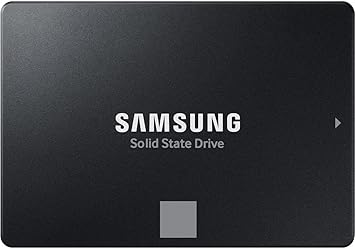SAMSUNG 870 EVO 4TB Sata III

The SAMSUNG 870 EVO 4TB is a 2.5-inch SATA III internal SSD that delivers impressive performance with sequential read speeds of up to 560 MB/s and sequential write speeds of up to 530 MB/s. It features a storage capacity of 4TB, making it an excellent choice for users needing ample space for their data and applications.
Popularity: High
Performance:
Specifications:
Model: SAMSUNG 870 EVO 4TB Sata III
Capacity: 4000.0 GB
Sequential Read Speed: Up to 560 MB/s Sequential Read
Sequential Write Speed: Up to 530 MB/s Sequential Write
Form Factor: 2.5 inch
Interface: SATA 6 Gbps Interface
Random Read Speed:
Random Write Speed:
Controller:
NAND Type:
Cache Memory: Samsung 4 GB Low Power DDR4 SDRAM
Endurance (TBW):
Power Consumption: Average: 2.5 W *Maximum: 5.0 W (Burst mode)
Operating Temperature:
Manufacturer Page: Link
Review
The SAMSUNG 870 EVO 4TB SATA III Internal SSD stands as a reliable testament to Samsung's enduring commitment to the SATA SSD realm in a market dominated by NVMe variants. Boasting an impressive storage capacity of 4TB, this SSD is an optimal choice for DIY builders and those seeking voluminous storage for extensive data and applications. Samsung’s investment in its SATA line, while swayed by market NVMe trends, ensures that the 870 EVO remains a premier contender for enthusiasts and professionals alike.
Performance and Specifications
Exhibited in a 2.5-inch form factor, the SAMSUNG 870 EVO 4TB is underpinned by Samsung's in-house MKX controller and 128-layer 3D TLC NAND flash technology. This combination promises sequential read speeds of up to 560 MB/s and write speeds reaching 530 MB/s, hitting the upper echelons of SATA III capabilities. When put to the test, the 870 EVO performs robustly during sequential tasks, offering consistency even under high loads (AnandTech).
A notable feature of this SSD is its DRAM cache, which aids in managing extensive data queues effectively. Samsung includes a 4 GB Low Power DDR4 SDRAM, which underpins its performance edge in random I/O operations compared to other SATA rivals like the Crucial MX500 (TechPowerUp).
Practical Usage Scenarios
While the market is teeming with faster NVMe options, the 870 EVO excels in scenarios where SATA's compatibility and reliability are paramount. Users upgrading existing systems or managing vast data repositories will find the drive's performance noteworthy. Tests have shown the 870 EVO's ability to maintain writing speeds even when its SLC cache is saturated, only dropping to a commendable 416 MB/s when filling its full capacity (TechPowerUp), ensuring reliability over sustained workloads. Furthermore, its availability in larger capacities is a significant boon for users with bulk storage needs.
Compared with Competitors
- Seagate Barracuda 120: While the Barracuda offers marginally better sustained write speeds, it fails to deliver the 4TB capacity that the 870 EVO conveniently does.
- Crucial MX500: Falls behind the 870 EVO in most performance measures but is a cost-effective alternative for budget-conscious users.
While NVMe drives like the Lexar NM790 exhibit superior speeds due to fewer interface constraints, the 870 EVO employs its strategic pricing and feature set to remain relevant, especially for systems lacking M.2 slots or the cooling infrastructure for NVMe SSDs (PCMag).
Pros and Cons
- Pros: Excellent sequential and random I/O performance, large capacity, reliable DRAM cache, and a robust warranty.
- Cons: More expensive than some NVMe alternatives and the limitations of the SATA interface in maximizing modern SSD performance.
Conclusion
The SAMSUNG 870 EVO 4TB SATA III Internal SSD is an exemplary choice for those rooted in the SATA ecosystem but desiring high-speed access to their extensive data collections. Its design, built on time-tested Samsung technologies, alongside its superior durability and performance metrics, reaffirms its position as a top-tier SATA SSD. Whether viewed through the lens of capacity or speed, the 870 EVO is a product that delivers, meriting its status among Samsung's 870 line, particularly for expansive digital storage solutions.